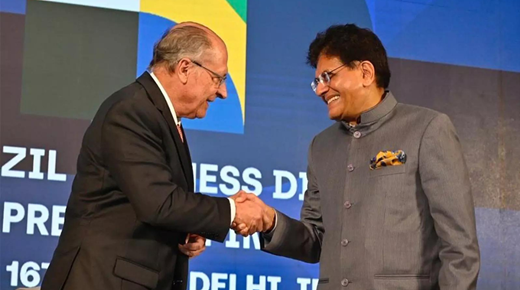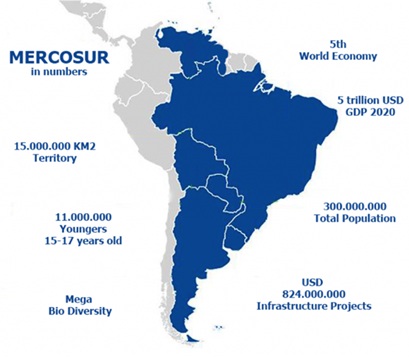(Prelims: Current Affairs)
(Mains, General Studies Paper 2: Bilateral, Regional, and Global Groups and Agreements Related to and/or Affecting India's Interests) |
Context
India and Brazil have agreed to expand the scope of the existing Preferential Trade Agreement (PTA) with the Mercosur bloc. The aim is to further strengthen economic ties between the two countries and increase India's access to the South American market.

About the Mercosur Bloc
- Mercosur stands for the Southern Common Market (South American Trade Bloc), a major trading bloc in South America.
- It was established on March 26, 1991, through the Treaty of Asunción and strengthened by the 1994 Protocol of Ouro Preto, which grants it legal personality.
- Its full members are Brazil, Argentina, Uruguay, Paraguay, and Bolivia, while Venezuela is a suspended member.
- Associate members include Chile, Colombia, Ecuador, Guyana, Peru, and Suriname.
- The bloc's primary objective is to ensure the free flow of goods, services, capital, and people between member countries.
- It is a customs union with a common external tariff (CET).
- Its GDP (PPP) in 2023 was approximately $5.7 trillion, making it the world's fifth-largest economy.

Expansion of the India-Mercosur Trade Agreement
- The existing PTA is effective from June 1, 2009. Currently, its scope is limited to only 450 tariff lines/products.
- Recent discussions took place between Brazilian Vice President Geraldo Alckmin and Indian Commerce and Industry Minister Piyush Goyal.
- Both sides agreed that the expansion of the agreement will be comprehensive and robust, covering both tariff and non-tariff aspects.
- The agreement aims to enable a significant portion of trade to benefit from tariff concessions.
- Technical dialogues and Joint Administrative Committee meetings will be held soon.
- Participation of the private sector and other stakeholders will be encouraged.
Provisions
- Extension Timing: Efforts to finalize the agreement within one year of the start of negotiations
- Tariff Exemptions: Both sides aim to provide tariff benefits to a large segment of trade
- Non-tariff Issues: Covers all aspects of trade and economic partnership
- Digital Partnership: Cooperation in Artificial Intelligence and High-Performance Computing
- Double Taxation Avoidance Agreement (DTAA): A secure and predictable environment for investment and trade
Significance
- Brazil is India's largest Latin American trading partner.
- Bilateral trade was $12.19 billion in 2024-25, with the goal of increasing it to $20 billion over the next five years.
- The extension of the agreement will enable India to gain a stronger foothold in the South American market.
- Private sector participation and digital partnerships will promote innovative technological and economic cooperation.
Challenges
- Managing trade and non-tariff barriers
- Ensuring active participation of the private sector and small entrepreneurs
- Coordinating in a consensual manner with other countries in the Mercosur blo
- Political and economic instability in the international market
Way Forward
- Expediting the technical dialogue and Joint Administrative Committee meetings
- Broadening and deepening the trade agreement to cover all tariff and non-tariff issues
- Collaboration in digital partnerships and AI-based high-performance computing
- Active participation and support of the private sector and stakeholders
- Establishing bilateral trade monitoring and review mechanisms to achieve strategic goals



